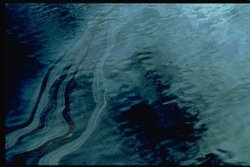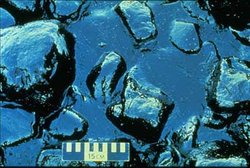Exxon Valdez oil spill
|
|
The Exxon Valdez oil spill was the most devastating domestic oil spill in the United States. Its remote location (accessible only by helicopter and boat) made government and industry response efforts difficult and tested existing plans for dealing with such an event. The region was habitat for salmon, sea otters, seals, and sea birds.
On March 23, 1989, the oil tanker Exxon Valdez departed from the Valdez oil terminal in Valdez, Alaska (on its 28th voyage), heading south through Prince William Sound, with a full load of oil. Captain Joseph Hazelwood radioed to the Coast Guard station that he would be changing course in order to avoid some growlers, small icebergs which had drifted into the sound from the Columbia Glacier. The captain received permission to move into the northbound lane. Before retiring to his cabin, Captain Hazelwood instructed his third mate Gregory Cousins to steer the vessel back into the southbound lane once it passed Busby Island. Although Cousins did give the instructions to the helmsman to steer the vessel to the right, the vessel was not turning sharply enough and at 12:04 a.m. on March 24, the vessel hit Bligh Reef. It is not known whether Cousins gave the orders too late, the helmsman did not follow instructions properly, or if something was wrong with the steering system of the vessel.
Journalist Greg Palast has argued that the accident was due to a corporate decision not to maintain the ship's Raycas radar in order to save money. Palast contends that the ship had been running without radar for at least a year. Between 11 million and 35 million US gallons (42,000 m³) of crude oil were spilled, affecting 1,900 km of coastline.
A trial burn was conducted during the early stages of the spill, in a region of the spill isolated from the rest by a fire-resistant boom. The test was relatively successful, but because of unfavorable weather no additional burning was attempted in this cleanup effort. Mechanical cleanup was started shortly afterward using booms and skimmers, but the skimmers were not readily available during the first 24 hours following the spill and thick oil and kelp tended to clog the equipment. Transferring oil from temporary storage vessels into more permanent containers was also difficult because of the oil's weight and thickness. In addition, a trial application of dispersants was performed. The use of dispersants proved to be controversial. Less than 4,000 US gallons (15,000 L) of dispersant were available in Valdez, Alaska, and no application equipment or aircraft. A private company applied dispersants on March 24 with a helicopter and dispersant bucket. Because there was not enough wave action to mix the dispersant with the oil in the water, their use was discontinued.
On February 27, 1990 Exxon and its shipping company were indicted on five criminal counts.
In the aftermath of the Exxon Valdez incident U.S. Congress passed the Oil Pollution Act of 1990, including a clause banning the Exxon Valdez from Alaskan waters. Exxon spent some 2 billion dollars cleaning up the spill with 11,000 workers, and a further 1 billion to settle civil and criminal charges related to the case. A lawsuit brought by fishermen, property owners, businesses and communities who claimed they were harmed by the spill is still in progress as of 2002. An award of $287 million for actual damage and $5 billion for punitive damages was awarded by an Anchorage jury in 1994. Exxon appealed against the ruling and the 9th U.S. Circuit Court of Appeals ordered the original judge Russel Holland to reduce the amount. On December 6, 2002 the judge announced that he had reduced the damages to $4 billion, which he concluded was justified by the facts of the case and not grossly excessive. Exxon's company position is that no punitive damages are justified because the spill was an accident. However in court it was argued that allowing a "known drunk" to captain the ship was reprehensible. Exxon sent it back to court, to be considered in regards to a recent supreme court ruling in a similar case, resulting in Judge Holland actually upping the punitive damages to $4.5 billion, plus interest. Exxon is again appealing, some fifteen years after the incident. The case currently sits in the 9th Circuit appelate court. The Exxon Valdez damages assessment is also important in that it was the first which assessed the existence value of the environmental resource in question, an assessment which was done through the use of contingent valuation techniques.
The tanker was towed to San Diego, arriving on July 10 and repairs began in July 30, 1989. Around 1,600 tons of steel was removed and replaced. In June 1990 the tanker, renamed SeaRiver Mediterranean left harbor after $30 million of repairs. The ship was banned from Valdez by a new regulation that prohibited vessels that had caused oil spills of more than 1 million US gallons (3,800 m³). In April 1998 the company argued in a legal action against government that the ship should be allowed back to Valdez, since the regulation was unfairly directed at Exxon alone (no other ships meet this criterion.)
OilCleanupAfterValdezSpill.jpeg
The long-term effects of the oil spill have been studied. Thousands of animals perished immediately, the best estimates are: 250,000 sea birds, 2,800 sea otters, 300 harbor seals, 250 bald eagles, up to 22 orcas, and billions of salmon and herring eggs. While as soon as a year later one had to look carefully on most beaches to find any evidence of the spill, the spill's effects continue to be felt. In the long term, declines have been observed in various marine populations, including stunted growth and indirect mortality increases in pink salmon populations. Sea otters and ducks also showed higher death rates years later, partly because they ate contaminated invertebrates. The animals also were exposed to oil when they dug up their prey in tainted soil. Researchers said some shoreline habitats, such as contaminated mussel beds, could take up to 30 years to recover. [1] (http://www.eurekalert.org/pub_releases/2003-12/uonc-evo121503.php)
On January 29, 1990 the trial of captain Joseph Hazelwood began in Anchorage, Alaska. Then on March 13, 1991 the United States Justice Department announced that Exxon had agreed to pay $1 billion for the clean-up of the spill. In fact, Exxon spent approximately $2 billion cleaning up the spill, which was mostly covered by Exxon's insurance, and which it wrote off on its taxes. Exxon has also paid damages of $50 million from an insurance fund.
According to reports from the Survivors of the Valdez Oil Spill, Exxon has earned approximately 800 million dollars a year on the money set aside to pay the punitive damages fine, which as of 2001, equalled $6 billion dollars, more than enough to pay the damage award without impacting the financial standing of the company. Exxon has been appealing the punitive damages award. In 1991, following the collapse of the local marine population (particularly clams, herring, and seals) the Chugach Native American group went bankrupt.
On an interesting note, it turns out that Exxon made a secret written agreement with a group of fish processing companies (known as the Seattle Seven), in which Exxon paid them $63.75 million in exchange for receiving almost all of their portion of the punitive proceeds from them (about $750 million), should the plaintiffs prevail. When judge Russel Holland discovered this fact, he excluded the Seattle Seven from the list of recipients of the award. However, the 9th U.S. Circuit Court of Appeals later ordered them put back in, only now they take a percentage off the top, before the rest of the class action claimants. This arrangement allows Exxon to recover a significant portion of whatever penalty they end up paying.
External links
- Scientists say Valdez spill impacts slow to fade (http://www.alertnet.org/thenews/newsdesk/N26549131.htm) - Reuters, January 27, 2005
- www.soundtruth.info Dr. Riki Ott has spent much of her professional life investigating the oil spill and it's aftermath.
- http://outside.away.com/magazine/1097/9710captain.html
Categories: Alaska | Oil spills | 1989


